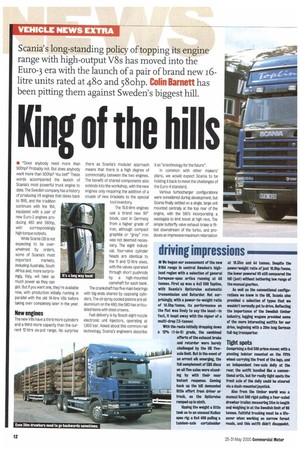King of the hills
Page 14

Page 15

If you've noticed an error in this article please click here to report it so we can fix it.
• "Does anybody need more than 500hp? Probably not. But does anybody want more than 500hpP You bet!" These words accompanied the launch of Scania's most powerful truck engine to date. The Swedish company has a history of producing V8 engines that dates back to 1916, and the tradition continues with the 164, equipped with a pair of new Euro-3 engines producing 480 and 580hp, with correspondingly high torque outputs.
While Scania GB is not expecting to be overwhelmed by orders, some of Scania's most important markets, including Australia, South Africa and, more surprisingly, Italy, will take as much power as they can get. But if you want one, they're available now, with production initially running in parallel with the old 14-litre V8s before taking over completely later in the year.
New engines
The new V8s have a third more cylinders and a third more capacity than the current 12-litre six-pot range. No surprise there as Scania's modular approach means that there is a high degree of commonality between the two engines. The benefit of shared components also extends into the workshop, with the new engines only requiring the addition of a couple of new brackets to the special tool inventory The 15.6-litre engines use a brand new 90° block, cast in Germany from a higher grade of iron, although compact graphite or "grey" iron was not deemed necessary. The eight individual, four-valve cylinder heads are identical to the 11 and 12-litre sixes, with the valves operated through short pushrods by a high-mounted camshaft for each bank.
The crankshaft has five main bearings with big-ends shared by opposing cylinders. The oil-spray cooled pistons are allaluminium on the 480; the 580 has articulated items with steel crowns.
Fuel delivery is by Bosch eight-nozzle electronic unit injectors, operating at 1,800 bar. Asked about this common-rail technology, Scania's engineers describe it as "a technology for the future".
In common with other makers' plans, we would expect Scania to be holding it back to meet the challenges of the Euro-4 standard.
Various turbocharger configurations were considered during development, but Scania finally settled on a single, large unit mounted centrally at the top rear of the engine, with the 580's incorporating a wastegate to limit boost at high revs. The simple butterfly valve exhaust brake is fitted downstream of the turbo, and produces an impressive maximum retardation of 300kW at 2,400rpm. The secondary brake has matched the ADR test, which involves maintaining a maximum of 30km/h over a 6km, 7% gradient at 44 tonnes—and did it at 62 tonnes. Scania claims the new unit outperforms the combined exhaust brake and retarder of the previous VB.
Smart fan
While the torque curves of the new engines are rather more peaky than the plateaux of the 14-litre units, the sheer bulk of the torque more than compensates. In particular, the 2,300Nm maximum of the old 530 is matched by the 580 at 900rpm, and although its 2,700Nm peak occurs from 1,1001,20Orpm, it produces more than 2,600Nm from 980-1.450rpm.
Handling all of the torque produced by the 580 version presented a challenge to the driveline engineers, but the S920 12+2 transmission only required modified versions of the existing gears to cope.
The gearbox oil-cooler on the 480 is mounted inside the 'vee" of the engine block, while the 580 has a separate unit under the cab cooled by an electric fan.
















































































































